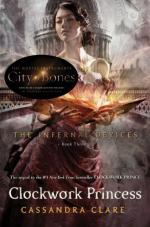
|
| Name: _________________________ | Period: ___________________ |
This test consists of 15 multiple choice questions and 5 short answer questions.
Multiple Choice Questions
1. How long ago did Cecily come to the London Institute, according to the narrator in Chapter 7: “Dare to Wish”?
(a) 3 weeks ago.
(b) 2 years ago.
(c) 8 weeks ago.
(d) 7 months ago.
2. What does Sophie give Gideon to drink while he recovers in Chapter 10: “Like Water upon Sand”?
(a) Lemonade.
(b) Orange juice.
(c) Posset.
(d) Scotch.
3. What is the setting that is described in the opening of the Prologue?
(a) Wales.
(b) London.
(c) York.
(d) Dublin.
4. Who is the Consul that writes to the Members of the Council in the opening of Chapter 5: “A Heart Divided”?
(a) Mortmain.
(b) Victor Whitelaw.
(c) Josiah Wayland.
(d) Benedict Lightwood.
5. The folk rhyme that opens Chapter 1: “A Dreadful Row” begins with the line “Marry on Monday for” what?
(a) “Love.”
(b) “Loss.”
(c) “Children.”
(d) “Health.”
6. What is the name of Gabriel and Gideon Lightwood’s father in the novel?
(a) Benedict Lightwood.
(b) Abraham Lightwood.
(c) Abel Lightwood.
(d) James Lightwood.
7. What is the name of the horse that Will had grown up riding and had to sell in Staffordshire because he didn’t have money for toll roads, according to the narrator in Chapter 12: “Ghosts on the Road”?
(a) Xanthios.
(b) Arthenon.
(c) Hengroen.
(d) Balios.
8. To what “notorious music hall and gentlemen’s club in Piccadilly Circus” does the Consul take Gabriel and Gideon in Chapter 6: “Let Darkness”?
(a) The Club Eremiel.
(b) Studio 54.
(c) The Argent Rooms.
(d) The Yin Fen Room.
9. What year is described in the opening of the Prologue?
(a) 1862.
(b) 1894.
(c) 1905.
(d) 1847.
10. How old was Jessamine when she first came to the London Institute?
(a) 15.
(b) 13.
(c) 14.
(d) 12.
11. Gabriel claims in Chapter 6: “Let Darkness” to have killed the worm by putting an arrow through it where?
(a) Its torso.
(b) Its heart.
(c) Its eye.
(d) Its tail.
12. When Will departs the unconscious and dying Jem in Chapter 10: “Like Water upon Sand,” he says “Atque in pepetuum, frater, ave atque vale.” What does this Latin phrase translate to in English?
(a) “Forever and ever, my brother, hail and farewell.”
(b) “Brothers in arms, brothers in souls.”
(c) “Loyalty forever, and nobility for all time.”
(d) “May the wind be always at your back, fair brother.”
13. What was the name of Gideon and Gabriel’s mother in the novel?
(a) Muriel Lightwood.
(b) Barbara Lightwood.
(c) Elizabeth Lightwood.
(d) Mary Lightwood.
14. What book is Tessa said to be halfway through reading “and finding it an excellent distraction” in Chapter 8: “That Fire of Fire”?
(a) A Midsummer Night’s Dream.
(b) A Tale of Two Cities.
(c) A Midwinter's Tale.
(d) The Castle of Otranto.
15. Where does Jessamine say Mortmain is as she dies in Chapter 9: “Graven in Metal”?
(a) The York Institute.
(b) Enkeli.
(c) Idris.
(d) Chriswick.
Short Answer Questions
1. In the letter from Gideon and Gabriel to the Consul in Chapter 8: “That Fire of Fire,” it is stated that Mrs. Branwell is “in almost daily communications with” what great-uncle of hers?
2. Who is the author of Confessions: Book IV from which the excerpt is taken which opens Chapter 10: “Like Water upon Sand”?
3. What month is it when the Institute’s carriage rolls into the gates of Lightwood House in Chapter 2: “The Conqueror Worm”?
4. What does Jem give to Will to sell for money for his drugs in Chapter 4: “To Be Wise and Love”?
5. What color dress is Aloysius Starkweather’s granddaughter wearing in the novel’s Prologue?
|
This section contains 552 words (approx. 2 pages at 300 words per page) |

|




